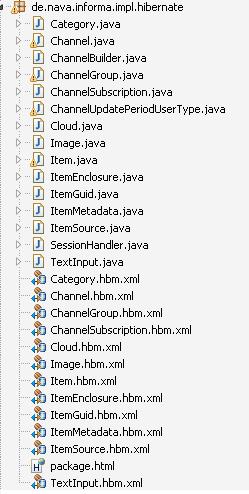和一般的Hibernate Entity domain一樣,在Informa的impl.hibernate包下,包含了兩種類型的文件:java文件和Hibernate的XML映射文件。

逐個逐個地打開這些java文件和xml文件來看,我發(fā)現(xiàn)了幾個特點:
A.多數(shù)的Hibernate實現(xiàn)和Basic實現(xiàn)的代碼都是一摸一樣的,這一點并不奇怪。因為本來就是實體bean
B.所有的Hibernate實現(xiàn)都沒有在構(gòu)造函數(shù)中調(diào)用IdGenerator生成ID,使用了數(shù)據(jù)庫生成的Id
在前面一節(jié)《RSS工具開發(fā)手記(08)---Informa的build.xml》中,我們提到了Informa的自定義task:schemaexport。這個task依靠于Hibernate的內(nèi)在類“org.hibernate.tool.hbm2ddl.SchemaExportTask”在CLASSPATH下搜尋hbm文件,然后把這些映射文件導(dǎo)出為ddl文件。
在這個包里面比較值得研究的有下面幾個:
A.Channel
B.ChannelBuilder
C.ChannelUpdatePeriodUserType
D.SessionHandler
★Channel
經(jīng)過和impl.basic包中Channel的比較,發(fā)現(xiàn)兩者的實現(xiàn)有如下的不同:
A.構(gòu)造方法中多了3個方法,兩個是使用title和location來構(gòu)造的,一個是使用Element,title,location來構(gòu)造的
B.從Hibernate中檢索出來的是不用設(shè)置ID的,而從內(nèi)存中生成的必須使用IdGenerator產(chǎn)生唯一ID
C.basic實現(xiàn)中沒有g(shù)etLocationString方法和setLocationString方法
D.basic實現(xiàn)中沒有g(shù)etSiteString方法和setSiteString方法
E.basic實現(xiàn)中沒有g(shù)etGroup方法和setGroup方法
F.basic實現(xiàn)中沒有g(shù)etFormatString和setFormatString方法
G.basic中沒有setItems方法,而且getItems方法中的實現(xiàn)不同(basic采用了同步的hashset,而hibernate沒有)
H.basic中的addItem方法是添加到hashmap,而hibernate中的addItem方法是添加到hashset
I.basic中的getItem方法是直接從map中根據(jù)ID獲取,而hibernate中的getItem是采用Iterator方法輪詢,而且不是從數(shù)據(jù)庫中獲取
我們來比較這兩個包中構(gòu)造方法的代碼:
impl.basic包
 public Channel(Element channelElement, String title) {
public Channel(Element channelElement, String title) { this.id = IdGenerator.getInstance().getId();
this.id = IdGenerator.getInstance().getId(); this.channelElement = channelElement;
this.channelElement = channelElement; this.title = title;
this.title = title; this.items = Collections.synchronizedMap((new LinkedHashMap<Long, ItemIF>()));
this.items = Collections.synchronizedMap((new LinkedHashMap<Long, ItemIF>())); this.categories = new ArrayList<CategoryIF>();
this.categories = new ArrayList<CategoryIF>(); this.observers = new ArrayList<ChannelObserverIF>();
this.observers = new ArrayList<ChannelObserverIF>(); this.format = ChannelFormat.UNKNOWN_CHANNEL_FORMAT;
this.format = ChannelFormat.UNKNOWN_CHANNEL_FORMAT; this.lastUpdated = new Date();
this.lastUpdated = new Date(); }
}impl.hibernate包
 public Channel(Element channelElement, String title, String location) {
public Channel(Element channelElement, String title, String location) { this.channelElement = channelElement;
this.channelElement = channelElement; this.title = title;
this.title = title; setLocationString(location);
setLocationString(location); this.items = new HashSet<ItemIF>();
this.items = new HashSet<ItemIF>(); this.categories = new ArrayList<CategoryIF>();
this.categories = new ArrayList<CategoryIF>(); this.observers = new ArrayList<ChannelObserverIF>();
this.observers = new ArrayList<ChannelObserverIF>(); this.groups = new HashSet<ChannelGroup>();
this.groups = new HashSet<ChannelGroup>(); this.format = ChannelFormat.UNKNOWN_CHANNEL_FORMAT;
this.format = ChannelFormat.UNKNOWN_CHANNEL_FORMAT; this.lastUpdated = new Date();
this.lastUpdated = new Date(); }
}首先最明顯的一個區(qū)別就是Id的生成不同了,其次在impl.basic中使用同步的HashMap來存儲items,而在impl.hibernate中使用了HashSet。但是在下面impl.hibernate的getItem的方法中,兩者的效率明顯有了區(qū)別:
impl.basic
 public ItemIF getItem(long anId) {
public ItemIF getItem(long anId) { return (ItemIF) items.get(new Long(anId));
return (ItemIF) items.get(new Long(anId)); }
}impl.hibernate
 public ItemIF getItem(long itemId) {
public ItemIF getItem(long itemId) { // TODO: improve performance
// TODO: improve performance // hibernate query cannot be used (not possible: no session object)
// hibernate query cannot be used (not possible: no session object) // may be use transient map: items.get(new Long(id));
// may be use transient map: items.get(new Long(id)); ItemIF theItem = null;
ItemIF theItem = null; Iterator it = items.iterator();
Iterator it = items.iterator(); while (it.hasNext()) {
while (it.hasNext()) { ItemIF curItem = (ItemIF) it.next();
ItemIF curItem = (ItemIF) it.next(); if (curItem.getId() == itemId) {
if (curItem.getId() == itemId) { theItem = curItem;
theItem = curItem; break;
break; }
} }
} return theItem;
return theItem; }
}
在Hibernate實現(xiàn)包中,由于使用了HashSet,只能使用逐個迭代的方式來輪詢檢查,當(dāng)item的數(shù)目比較多時,無疑效率被第一種低了很多。在作者的注釋中也提到了可以使用map。特別的這個getItem并非從數(shù)據(jù)庫的ITEMS表取出的。為什么要這樣做呢?
在查看了Channel的xml映射文件后,我有了一點頭緒
 <set name="items" table="ITEMS" lazy="false" inverse="true"
<set name="items" table="ITEMS" lazy="false" inverse="true" cascade="all-delete-orphan">
cascade="all-delete-orphan"> <key column="CHANNEL_ID" />
<key column="CHANNEL_ID" /> <one-to-many class="de.nava.informa.impl.hibernate.Item" />
<one-to-many class="de.nava.informa.impl.hibernate.Item" /> </set>
</set>注意其中的lazy="false"屬性,這意味著當(dāng)我們從數(shù)據(jù)庫中檢索Channel時,對應(yīng)的item都會被檢出,然后填充到entity bean中,所以此時直接從Channel中的HashSet中拿就可以了。
至于同步方面我想原因可能是:impl.basic包中的實現(xiàn)是在內(nèi)存中實現(xiàn)的,所以對于items必須進(jìn)行同步。因此使用了Collections.synchronizedMap對訪問或存儲的item進(jìn)行同步。而hibernate實現(xiàn)包中由于是Hibernate管理同步,所以不需要顯式地使用Collections.synchronizedSet來同步這個Set。
至于為什么在basic和hibernate包中有些屬性和方法是不存在的,構(gòu)造方法也有不同,這兩點還有待于和作者探討。
-------------------------------------------------------------
生活就像打牌,不是要抓一手好牌,而是要盡力打好一手爛牌。






